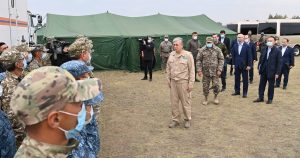Kazakh President Kassym-Jomart Tokayev visited the northern region of Kostanay on September 5 after the area was devastated by wildfires exacerbated by high temperatures and winds. According to Kazakhstan’s Emergency Situations Ministry, as of September 4 fires had spread to 43,000 hectares, threatening the villages of Amankaragai, Lesnoye, Ozernoye, Baganaly, and Kalinino.
In total, the ministry said in a September 6 press release after the fires were contained, 91 residential buildings were damaged, most in Amankaragai. One elderly man died in the fires, reportedly after refusing to evacuate from the village. Around 1,800 people were evacuated.
Tokayev toured the affected area by helicopter.
According to RFE/RL’s Kazakh Service, Tokayev’s visit to Kostanay was originally intended to celebrate Akhmet Baitursynov, a Kazakh intellectual from the region executed during Stalin’s Great Purge in 1937. Had the wildfires not derailed those plans, his trip would have also been viewed through the lens of the likely early presidential election, which Tokayev called for on September 1.
In meeting with evacuees, Tokayev promised that “the government will build new houses for the victims within two to two and a half months.”
A cause of the fires has not been determined, though high temperatures and winds worsened the blaze. One activist interviewed by RFE/RL said forestry services were underfunded in the country, meaning there are few specialists. The activist, Saken Dildahmet, said “there are few forests in Kazakhstan, and we need to conserve them.”
A climate risk profile of Kazakhstan published by the World Bank and Asian Development Bank in June 2021 warned that “Fires in steppe and forest areas are projected to become more frequent in the coming decades, driven by higher temperatures and more frequent droughts, leading to degradation of land.”
Last summer, Kazakhstan’s south and western regions experienced extreme heat and drought. In neighboring Akmola Region (also home to the Kazakh capital, Nur-Sultan), earlier this summer farmers complained of disease, drought, and little government help.
As an article published earlier this year in Central Asian Survey argued, although it’s clear that Central Asia is vulnerable to the impacts of climate change, “The available research, however, is miniscule compared with the magnitude of the problem.” The authors reviewed available literature and events focused on the region in the past 30 years and found climate change to be a neglected subject.
Although wildfires are not directly mentioned in the analysis, they stand as yet another aspect of climate change that is arguably understudied in the region. With rising temperatures and intensified droughts major concerns for Central Asia, wildfires are likely to worsen in the years ahead. While Kazakh authorities say the recent fires will not affect Kazakhstan’s food security, Kostanay is a major wheat growing region. The recent fires, mostly in forested areas, may not have hit the wheat fields, but the next fire might and that should be of grave concern.

































